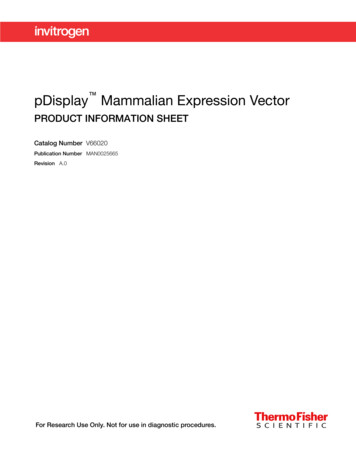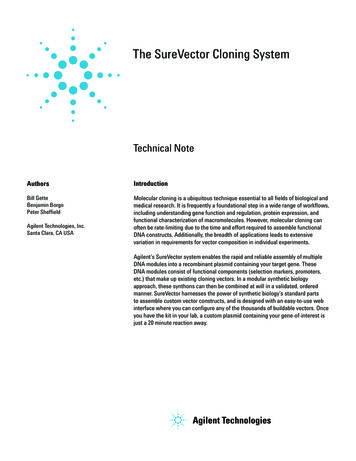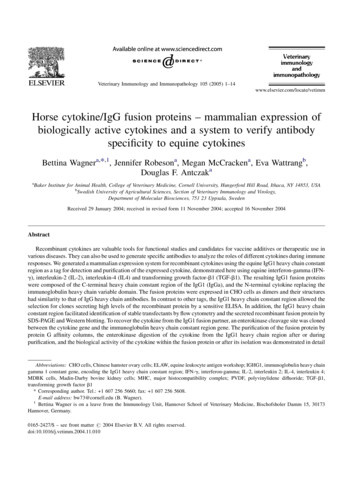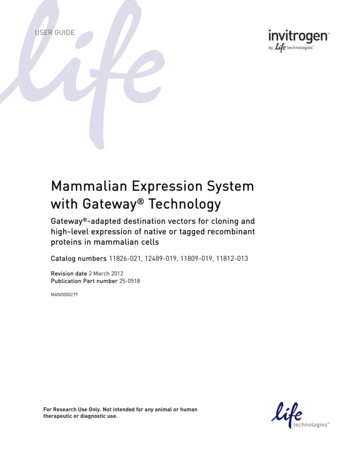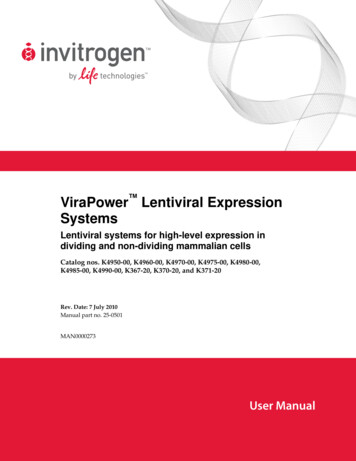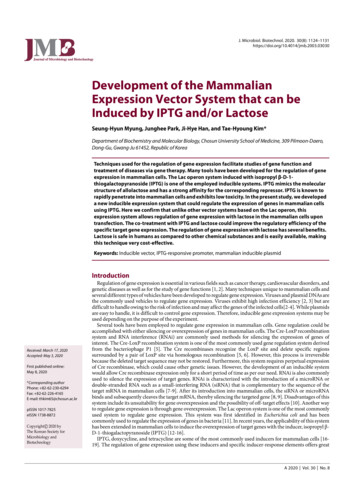
Transcription
J. Microbiol. Biotechnol. 2020. 30(8): evelopment of the MammalianExpression Vector System that can beInduced by IPTG and/or LactoseSeung-Hyun Myung, Junghee Park, Ji-Hye Han, and Tae-Hyoung Kim*Department of Biochemistry and Molecular Biology, Chosun University School of Medicine, 309 Pilmoon-Daero,Dong-Gu, Gwang-Ju 61452, Republic of KoreaTechniques used for the regulation of gene expression facilitate studies of gene function andtreatment of diseases via gene therapy. Many tools have been developed for the regulation of geneexpression in mammalian cells. The Lac operon system induced with isopropyl β-D-1thiogalactopyranoside (IPTG) is one of the employed inducible systems. IPTG mimics the molecularstructure of allolactose and has a strong affinity for the corresponding repressor. IPTG is known torapidly penetrate into mammalian cells and exhibits low toxicity. In the present study, we developeda new inducible expression system that could regulate the expression of genes in mammalian cellsusing IPTG. Here we confirm that unlike other vector systems based on the Lac operon, thisexpression system allows regulation of gene expression with lactose in the mammalian cells upontransfection. The co-treatment with IPTG and lactose could improve the regulatory efficiency of thespecific target gene expression. The regulation of gene expression with lactose has several benefits.Lactose is safe in humans as compared to other chemical substances and is easily available, makingthis technique very cost-effective.Keywords: Inducible vector, IPTG-responsive promoter, mammalian inducible plasmidIntroductionReceived: March 17, 2020Accepted: May 3, 2020First published online:May 8, 2020*Corresponding authorPhone: 82-62-230-6294Fax: 82-62-226-4165E-mail: thkim65@chosun.ac.krpISSN 1017-7825eISSN 1738-8872Copyright 2020 byThe Korean Society forMicrobiology andBiotechnologyRegulation of gene expression is essential in various fields such as cancer therapy, cardiovascular disorders, andgenetic diseases as well as for the study of gene functions [1, 2]. Many techniques unique to mammalian cells andseveral different types of vehicles have been developed to regulate gene expression. Viruses and plasmid DNAs arethe commonly used vehicles to regulate gene expression. Viruses exhibit high infection efficiency [2, 3] but aredifficult to handle owing to the risk of infection and may affect the genes of the infected cells[2-4]. While plasmidsare easy to handle, it is difficult to control gene expression. Therefore, inducible gene expression systems may beused depending on the purpose of the experiment.Several tools have been employed to regulate gene expression in mammalian cells. Gene regulation could beaccomplished with either silencing or overexpression of genes in mammalian cells. The Cre-LoxP recombinationsystem and RNA interference (RNAi) are commonly used methods for silencing the expression of genes ofinterest. The Cre-LoxP recombination system is one of the most commonly used gene regulation system derivedfrom the bacteriophage P1 [5]. The Cre recombinases recognize the LoxP site and delete specific regionssurrounded by a pair of LoxP site via homologous recombination [5, 6]. However, this process is irreversiblebecause the deleted target sequence may not be restored. Furthermore, this system requires perpetual expressionof Cre recombinase, which could cause other genetic issues. However, the development of an inducible systemwould allow Cre recombinase expression only for a short period of time as per our need. RNAi is also commonlyused to silence the expression of target genes. RNAi is characterized with the introduction of a microRNA ordouble-stranded RNA such as a small-interfering RNA (siRNA) that is complementary to the sequence of thetarget mRNA in mammalian cells [7-9]. After its introduction into mammalian cells, the siRNA or microRNAbinds and subsequently cleaves the target mRNA, thereby silencing the targeted gene [8, 9]. Disadvantages of thissystem include its unsuitability for gene overexpression and the possibility of off-target effects [10]. Another wayto regulate gene expression is through gene overexpression. The Lac operon system is one of the most commonlyused system to regulate gene expression. This system was first identified in Escherichia coli and has beencommonly used to regulate the expression of genes in bacteria [11]. In recent years, the applicability of this systemhas been extended in mammalian cells to induce the overexpression of target genes with the inducer, isopropyl βD-1-thiogalactopyranoside (IPTG) [12-16].IPTG, doxycycline, and tetracycline are some of the most commonly used inducers for mammalian cells [1619]. The regulation of gene expression using these inducers and specific inducer-response elements offers greatA 2020 Vol. 30 No. 8
IPTG/Lactose-inducible Mammalian Vector1125advantages. These methods may allow induction of target gene expression in mammalian cells as per ourrequirement. IPTG is a promising inducer, as it is less toxic than other inducers such as doxycycline andtetracycline [20, 21] and exhibits high affinity (Ka 106 M 1) [22]. In addition, IPTG rapidly penetrates intomammalian cells [23] and irreversibly binds to the Lac repressor, leading to the induction of target geneexpression. Although the Lac operon system offers these advantages, there are some associated limitations. Theprotein of interest may leak under non-inducing conditions [16] and affect the interpretation of results.The number and location of Lac operators are important for the regulation of gene expression in E. coli [15, 24].The most important Lac operator is located between the promoter and transcription start point [25]. The Lacrepressor is bound to this Lac operon and prevents the binding between the promoter and RNA polymerase II[25]. Other two Lac operators are located in 3′ upstream region from the Lac operon promoter [24, 25]. Lacrepressors bind to Lac operators and form tetramers, which create a DNA loop between Lac operators [26]. Thesetwo Lac operators are also important to regulate Lac operon expression in E. coli. We thought that the mutations ofthe five Lac operators may affect their binding to the Lac repressors and consequently inhibit the target geneexpression. We designed an inducible vector to regulate the expression of important genes in mammalian cellswith five Lac operators to address the limitations related with previous systems. In the present study, we designedan inducible vector for the regulation of gene expression in mammalian cells. Further, we observed that lactosecould serve as an inducer for our system and improve the efficiency of our inducible vector upon co-treatmentwith IPTG.Materials and MethodsCell Culture and TransfectionHEK293, HeLa, and B16F10 cells were obtained from the Korean Cell Line Bank and maintained in Dulbecco’smodified Eagle’s medium (DMEM) containing 5% fetal bovine serum (FBS) (Merk, USA) and 1% penicillinstreptomycin (Corning, USA), ciprofloxacin (Fluka, USA), and gentamycin (Duchefa Biochemie, TheNetherlands). All three cell lines were cultured in a 5% CO2 incubator at 37 C. HEK293, HeLa and B16F10 cellswere plated in T75 flasks and transfected with 20 μg of control vector or inducible vector using 60 μg ofpolyethylenimine (PEI, molecular weight 4,000) (Poly Science, USA).Induction of GFP ExpressionBefore GFP expression induction, the transfected cells were plated in 24-well plates and treated with isopropylβ-D-1-thiogalactopyranoside (IPTG) (Sigma-Aldrich, USA) and/or lactose (Sigma-Aldrich) at indicatedconcentrations. The cells were analyzed for GFP expression under a confocal microscope.Fluorescence MicroscopyTransfected cells were seeded into 24 well plates (1 105 cells/well). After treatment with the inducers, IPTGand/or lactose, the nuclei were stained with Hoechst dye at indicated time points. The cells were washed withphosphate-buffered saline (PBS) and fixed with 4% paraformaldehyde in PBS for 10 min at room temperature.Cells were washed again with PBS and incubated in PBS in 24-well plates to evaluate GFP expression and Hoechststaining under an Olympus FluoView FV1000 confocal laser scanning microscope (Olympus, Shinjuku Monolith,2-3-1, Japan)Western Blot AnalysisFor immunoblotting analysis, the cells transfected with control and inducible vectors were seeded in 60 mmplates. After attachment, the cells were treated with the inducers, IPTG and/or lactose, at indicated concentrations.The cells were harvested at 0 and 24 h using radioimmunoprecipitation assay (RIPA) buffer (50 mM Tris-HCl pH7.4, 1% NP-40, 0.5% Na-deoxycholate, 0.1% sodium dodecyl sulfate [SDS], 150 mM sodium chloride [NaCl],2 mM ethylenediaminetetraacetic acid [EDTA], and 1/1000 protease inhibitor cocktail, Sigma-Aldrich). Proteinconcentrations were quantified with the bicinchoninic acid (BCA) assay method (ThermoFisher Scientific, USA).About 30 μg of proteins were separated with SDS polyacrylamide gel electrophoresis and the separated proteinbands were transferred onto polyvinylidene fluoride (PVDF) membranes (GE Healthcare Life Science, USA)using an electro-transfer machine at 100 mA for 400 min. The membranes were blocked with 5% skim milk (BD;Becton, Dickinson and Company, USA) for 1 h and incubated with primary antibodies against GFP (SantaCruz,USA) and glyceraldehyde 3-phosphate dehydrogenase (GAPDH)(Cell Signaling, USA) for 2 h, followed bywashing thrice with Tris-buffered saline-0.05% Tween-20 (TBST) buffer for 15 min. The membranes were probedwith a secondary goat anti-rabbit IgG (1:3000 dilution in TBST buffer) (ThermoFisher Scientific) for 1 h and thenwashed four times with TBST buffer for 15 min. The membranes were developed with chemiluminescenthorseradish peroxidase substrates (Millipore, USA).ResultsThe Design of An Inducible Vector SystemThe location and number of Lac operators are important in the Lac operon system to regulate the expression oftarget genes [12-14]. Here, we developed a vector system for the regulation of gene expression in animal cells basedon the results of previous studies. We first designed a vector with five Lac operators, a CMV enhancer, and a CMVpromoter-mini, which could strongly induce the expression of GFP used as the reporter (Fig. 1A). CMVpromoter-mini is a sequence corresponding to the minimized size of a functional promoter of mammalian cellsA 2020 Vol. 30 No. 8
1126Myung et al.Fig. 1. The scheme of inducible vector, pCalo5-GFP-LacI. (A) The control vector, pCalo5-GFP against pCalo5-GFPLacI, (B) The inducible vector, pCalo5-GFP-LacI has five operators, Blasticidin gene, P2A gene and LacI gene. Three operatorsare located between CMV promoter and GFP ORF. The other operator is located between the promoter and the enhancer, andanother one is located upstream from the enhancer. (C)The GFP expression is suppressed by inhibition of repressors when theinducers are not treated. (D)When the inducers are treated, repressors are bind to inducers such as IPTG. After that, The GFPcan be expressed by transcription factors.[27]. Five Lac operators could inhibit GFP expression in the presence of the simultaneous expression of Lacrepressors in the same cell. The location of each operator was as follows: One operator was located in the 5′upstream region from the CMV enhancer, while another operator was located between the CMV enhancer andCMV promoter-mini. The other three operators were located between CMV promoter-mini and the transcriptionstart point of GFP (Figs. 1A and B). We constructed the inducible vector by inserting LacI gene fused to the geneencoding blasticidin S deaminase (BSD) and P2A gene. The SV40 promoter could strongly induce thetranscription of LacI gene in mammalian cells. We termed this inducible vector as pCalo5-GFP-LacI (Fig. 1B).The LacI repressor gene was fused to blasticidin gene and P2A, which is a protease that can cleave its C-terminalsite. After the expression of LacI gene, the LacI repressor fused with blasticidin and P2A was cleaved by P2A,owing to its self-cleavage activity [28]. Therefore, we could select the transfected cells with pCalo5-GFP-LacIvector using blasticidin (Fig. 1B). The LacI repressor could bind to Lac operators on the regulatory region ofpCalo5-GFP-LacI and inhibit GFP expression in mammalian cells (Fig. 1C). However, GFP could be expressedupon treatment with the inducer, IPTG (Fig. 1D). Therefore, we expect that the mammalian cells transfected withthis vector show no transcription of the target gene until being induced with IPTG.Regulation of Gene Expression with IPTG or LactoseThe Lac operon system uses lactose as an energy source under low glucose environment in E. coli. Allolactose isan inducer that is transformed from lactose by the enzyme β-galactosidase and induces the expression of lacZ,lacY, and lacA genes after binding to the repressor. IPTG is a mimetic chemical of allolactose and exhibits goodcellular permeability and low cytotoxicity. It is used as an inducer in most studies with the Lac operon. However,allolactose has about two times higher affinity for the repressor than IPTG [23]. Therefore, we thought thatlactose, an isoform of allolactose, could bind to the repressor even though it has a weak binding affinity. Toinvestigate whether GFP expression could be regulated with IPTG and lactose in mammalian cells, we transfectedpCalo5-GFP as a control vector or pCalo5-GFP-LacI vectors into HEK293 cells. As a result, we observed that thecells transfected with pCalo5-GFP showed GFP expression. After transfection with pCalo5-GFP, HEK293 cellsexpressed GFP regardless of the induction time and IPTG and lactose concentrations (Fig. 2A). However, the cellstransfected with pCalo5-GFP-LacI had almost no GFP expression without IPTG or lactose. After treatment withIPTG, HEK293 cells transfected with pCalo5-GFP-LacI showed weak GFP expression. However, no significantdifference in the level of GFP expression was observed between HEK293 cells treated with 1 and 3 mM IPTG. Toeffectively induce GFP expression, IPTG should be used at a concentration of at least 1 mM for over 24 h (Fig. 2B).Although lactose could induce GFP expression at a very low level after 24 h in HEK293 cells, we observed that itcould also induce GFP expression in mammalian cells (Fig. 2B). Thus, lactose has the potential to serve as aninducer in mammalian cells expressing the Lac operator.The Additive Effect of IPTG and Lactose To Elevate the Expression Level of GFPIPTG irreversibly binds to the Lac repressor as an agonist of allolactose and induces the expression of targetgenes. The results in Fig. 2 show that IPTG alone was insufficient to induce the expression of GFP. IPTG andJ. Microbiol. Biotechnol.
IPTG/Lactose-inducible Mammalian Vector1127Fig. 2. The expression of GFP using IPTG or lactose in HEK293 cell line. Transfected HEK293 cells were seededinto 24 well plates (1 105 cells/well) before induction of gene expression. Various concentrations of IPTG or lactose weretreated into transfected HEK293 cells for the indicated time. After indicated time, 10 μg/ml of Hoechst was treated into eachwell for 10 min and 4% Paraform-aldehyde was treated into each well for fixation of cells for 10 min. The green color representsexpressed GFP in HEK293 cells and the blue color represents nucleus stained by Hoechst.Fig. 3. The increase of expression of GFP by co-treatment of IPTG and lactose. (A) HEK293 cells transfected withindicated vector were seeded into 24 well plates (1 105 cells/well) before induction of gene expression. After 8 h, variousconcentrations of IPTG and/or lactose were treated into transfected HEK293 cells for 0 h and 24 h. After indicated time, 10 μg/ml of Hoechst were treated into each well for 10 min and 4% Paraformaldehyde were treated into each well for fixation of cellsfor 10 min. The green color represents expressed GFP in HEK293 cells and the blue color represents nucleus stained byHoechst. (B) GFP expression can be regulated in other cell lines. Transfected B16F10, HeLa, and HEK293T cells were seededinto 24 well plates (1 105 cells/well). After 8 h, IPTG and/or lactose were treated into transfected cells for 24 h. After inductionof GFP expression by IPTG and/or lactose, GFP expression level was analyzed by Western blot. GAPDH was used as controlprotein. Reactive bands were indicated by arrow.A 2020 Vol. 30 No. 8
1128Myung et al.allolactose bind to the same position on the Lac repressor and allolactose has two times higher affinity for thepromoter than IPTG. Lactose is an isoform of allolactose and could induce the expression of GFP, although thelevel of GFP expression was very low (Fig. 2B). The effect of lactose on the LacI repressor is unclear. We thoughtthat lactose may exert an additive effect on the induction of GFP expression. We tested whether the co-treatmentwith IPTG and lactose could increase the efficiency of GFP expression. As a result, we found that the expressionlevel of GFP was higher after co-treatment with IPTG (1 mM) and lactose (100 mM) than with IPTG alone after 24h in HEK293 cells transfected with pCalo5-GFP-LacI (Fig. 3A). To quantitatively confirm these results, we carriedout western blot analysis using cell lysates after 24 h of treatment with inducers, IPTG and/or lactose (Fig. 3B). Weobserved that GFP expression was stronger in B16F10, HeLa, and HEK293 cells transfected with pCalo5-GFPLacI after co-treatment with IPTG and lactose than that observed after IPTG or lactose treatment alone (Fig. 3B).Thus, lactose could also improve gene expression in other mammalian cells expressing the Lac operon upon cotreatment with IPTG. It may also affect the inhibitory function of the Lac repressor in mammalian cells.The Optimum Concentration for the Efficient Induction of GFP ExpressionWe observed that the co-treatment with IPTG and lactose could induce higher GFP expression than thetreatment with IPTG or lactose alone. We confirmed the optimum concentration of inducers for the efficientinduction of GFP expression with our inducible vector system. We simultaneously treated HEK293 cells withvarious concentrations of lactose and 1 mM of IPTG, which was the saturated concentration for the induction ofGFP expression (Fig. 2B). We could observe that the expression level of GFP increased based on the concentrationof lactose (Fig. 4). However, high concentration of lactose may cause osmotic shock and cell death. In ourexperiments, HEK293 cells began to die at lactose concentrations above 100 mM. We decided to use 75 mM as theoptimum lactose concentration for the efficient expression of GFP because this concentration induced maximumGFP expression and caused minimum cell death (Fig. 4). We improved the efficiency of our inducible vectorsystem by co-treatment with IPTG and lactose. However, this system still has low efficiency of gene expression,which needs to be addressed.The Deletion of Lac Operators for the Efficient Regulation of Gene ExpressionThe vector pCalo5-GFP-LacI has five operators and strongly silences the target gene expression. However, thisvector system could induce only low level of GFP expression. Hence, we thought that the five operators massivelyFig. 4. Optimal concentration for expression of GFP by IPTG and lactose in HEK293 cell line. HEK293 cellstransfected with indicated vector were seeded into 24 well plates (1 105 cells/well) before induction of gene expression. After8 h, indicated lactose with 1 mM of IPTG was treated into transfected HEK293 cells for 0 h and 24 h. After indicated time, 10 μg/mlof Hoechst was treated into each well for 10 min and 4% paraformaldehyde was treated into each well for fixation of cells for10 min.J. Microbiol. Biotechnol.
IPTG/Lactose-inducible Mammalian Vector1129Fig. 5. The efficiency of inducible vectors by co-treatment of IPTG and lactose in HEK293 cell line. (A) Theinducible vector, pCalo5-GFP-LacI-Del-II was modified from pCalo5-GFP-LacI by eliminate operator located between CMVpromoter and enhancer. (B) The inducible vector, pCalo5-GFP-LacI-Del-III was modified from pCalo5-GFP-LacI by eliminateoperators located between CMV promoter and GFP ORF. (C) HEK293 cells transfected with indicated vectors were seeded into24 well plates (1 105 cells/well) before induction of gene expression by IPTG and/or lactose. After 8 h, various concentrationsof IPTG and/or lactose were treated into transfected HEK293 cells for 0 h and 24 h. After indicated time, 10 μg/ml of Hoechstwas treated into each well for 10 min and 4% Paraformaldehyde were treated into each well for fixation of cells for 10 min. (D)After induction of GFP expression by IPTG and/or lactose at the indicated concentrations for 24 h, GFP expression level wasanalyzed by western blot. GAPDH was used as control protein. Reactive bands were indicated by arrow, and asterisk indicatednonspecific bands.A 2020 Vol. 30 No. 8
1130Myung et al.block the binding of RNA polymerase II to CMV promoter-mini region through the LacI repressors, andsignificantly reduce the expression of GFP after inducer treatment. Thus, we constructed two modified induciblevectors by deleting the Lac operators from pCalo5-GFP-LacI vector to improve the expression level of ourinducible vector system (Figs. 5A and B). We termed the resulting two vectors as pCalo5-GFP-LacI-Del-II andpCalo5-GFP-LacI-Del-III. The pCalo5-GFP-LacI-Del-II vector was constructed by the deletion of the Lacoperator between CMV enhancer and CMV promoter-mini, while pCalo5-GFP-LacI-Del-III was derived afterthe deletion of three Lac operators between CMV promoter-mini and GFP gene.We tested the efficiency of pCalo5-GFP-LacI-Del-II and pCalo5-GFP-LacI-Del-III vectors for regulating GFPexpression in HEK293 cells. HEK293 cells transfected with pCalo5-GFP-LacI-Del-II vector showed completeabrogation of GFP expression after 24 h until being treated with inducers, and these cells expressed higher level ofGFP than those transfected with pCalo5-GFP-LacI vector after 24 h of co-treatment with IPTG and lactose (Fig.5C). The amount of GFP was measured by western blotting and the expression level was compared betweenHEK293 cell transfected with GFP-LacI-Del-II and GFP-LacI vectors. We confirmed that HEK293 cellstransfected with GFP-LacI-Del-II vector hardly expressed any GFP before co-treatment with IPTG and lactosebut expressed higher level of GFP than HEK293 cells transfected with pCalo5-GFP-LacI (Fig. 5D). However, theexpression of GFP could not be regulated by inducers in HEK293 cells transfected with pCalo5-GFP-LacI-Del-IIIvector; continuous GFP expression was observed after transfection with pCalo5-GFP-LacI-Del-III vector (Fig.5C). This observation could be attributed to the deletion of the three operators in the direction of RNA polymeraseII to transcribe GFP. We showed the importance of locations and number of Lac operators; our results wereconsistent with those of previous studies [24-26]. Taken together, we demonstrated that the pCalo5-GFP-LacIDel-II inducible vector system can be regulated with IPTG and lactose in mammalian cells and confirmed thatlactose could serve as an inducer with IPTG and improve the efficiency of gene expression regulation inmammalian cells expressing the Lac operon system.DiscussionThe development of tools for the regulation of important genes would reveal the functions and roles of severalgenes and could be useful for the treatment of genetic diseases. Many tools have been designed for the regulation ofgene expression. Among these, the Lac operon system is used for the regulation of gene expression. IPTG is used asthe inducer in the Lac operon system and offers great advantages. IPTG has high affinity for the LacI repressor (Ka 106 M 1) [22] and rapidly infiltrates into mammalian cells [23]. In addition, IPTG is stable at high temperaturesand low pH [29]. These advantages have extended the application of the Lac operon system with mammalian cells.However, several tools based on the Lac operator-repressor system is a quite complicate expression systemshowing leaky expression of genes under non-inducing conditions [16] and may not dramatically turn on/off ofthe expression of genes. Here, we designed a simple inducible vector to address these issues. We show that thepCalo5-GFP-LacI vector tightly suppressed GFP expression under non-inducing conditions while inducing itsexpression in the presence of IPTG and/or lactose.Jebe et al. (1973) showed the ability of lactose to bind to the LacI repressor and act as an anti-inducer in E. coli[30]. Lactose could bind to the LacI repressor at a concentration similar to that of IPTG under saturationconditions with a Ka value of 2 10 4 [30]. However, in the present study, we observed that lactose could alsoinduce GFP expression and improve the induction efficiency of GFP expression in the presence of IPTG inmammalian cells. The tools using the Lac operon and repressor often show conflicting results with lactosebetween E. coli and mammalian cells. These differences may be associated with the variations in the infiltrationability of lactose into these cell types. Therefore, it is important to study the functions of lactose using the Lacoperator and repressor in mammalian cells.Although lactose failed to induce high level GFP expression in our inducible expression system, it couldpromote the expression of genes that may not be induced with IPTG. The regulation of important genes withlactose has great advantages. Lactose could be applied to other tools based on the Lac operator and repressorsystem to improve the induction efficiency of gene expression. Lactose is also easily available and the use of thesetools to regulate the expression of genes with Lac operator and repressor is cost-effective.AcknowledgmentsThis study was supported by funding from Chosun University, 2019.Conflicts of InterestThe authors have no financial conflicts of interest to declare.References1. Wirth T, Parker N, Yla-Herttuala S. 2013. History of gene therapy. Gene 525: 162-169.2. Kim TK, Eberwine JH. 2010. Mammalian cell transfection: the present and the future. Anal. Bioanal. Chem. 397: 3173-3178.3. Luten J, van Nostrum CF, De Smedt SC, Hennink WE. 2008. Biodegradable polymers as non-viral carriers for plasmid DNA delivery.J. Control Release 126: 97-110.4. Xu ZL, Mizuguchi H, Ishii-Watabe A, Uchida E, Mayumi T, Hayakawa T. 2001. Optimization of transcriptional regulatory elementsfor constructing plasmid vectors. Gene 272: 149-156.5. Sauer B, Henderson N. 1988. Site-specific DNA recombination in mammalian cells by the Cre recombinase of bacteriophage P1.Proc. Natl. Acad. Sci. USA 85: 5166-70.J. Microbiol. Biotechnol.
IPTG/Lactose-inducible Mammalian Vector11316. Sternberg N. 1981. Bacteriophage P1 site-specific recombination. III. Strand exchange during recombination at lox sites. J. Mol. Biol.150: 603-608.7. Fire A, Xu S, Montgomery MK, Kostas SA, Driver SE, Mello CC. 1998. Potent and specific genetic interference by double-strandedRNA in caenorhabditis elegans. Nature 391: 806-811.8. Saurabh S, Vidyarthi AS, Prasad D. 2014. RNA interference: concept to reality in crop improvement. Planta 239: 543-564.9. Wang QL, Li ZH. 2007. The functions of microRNAs in plants. Front. Biosci. 12: 3975-3982.10. Qiu S, Adema CM, Lane T. 2005. A computational study of off-target effects of RNA interference. Nucleic Acids Res. 33: 1834-1847.11. Jacob F, Monod J. 1961. Genetic regulatory mechanisms in the synthesis of proteins. J. Mol. Biol. 3: 318-356.12. Brown M, Figge J, Hansen U, Wright C, Jeang KT, Khoury G, et al. 1987. lac repressor can regulate expression from a hybrid SV40early promoter containing a lac operator in animal cells. Cell 49: 603-612.13. Hu MC, Davidson N. 1987. The inducible lac operator-repressor system is functional in mammalian cells. Cell 48: 555-566.14. Edamatsu H, Kaziro Y, Itoh H. 1997. Inducible high-level expression vector for mammalian cells, pEF-LAC carrying humanelongation factor 1alpha promoter and lac operator. Gene 187: 289-294.15. Scrable H. 2002. Say when: reversible control of gene expression in the mouse by lac. Semin. Cell Dev. Biol. 13: 109-119.16. Deans TL, Cantor CR, Collins JJ. 2007. A tunable genetic switch based on RNAi and repressor proteins for regulating gene expressionin mammalian cells. Cell 130: 363-372.17. Gossen M, Bujard H. 1992. Tight control of gene expression in mammalian cells by tetracycline-responsive promoters. Proc. Natl.Acad. Sci. USA 89: 5547-5551.18. Ramos JL, Martinez-Bueno M, Molina-Henares AJ, Teran W, Watanabe K, Zhang X, et al. 2005. The TetR family of transcriptionalrepressors. Microbiol. Mol. Biol. Rev. 69: 326-356.19. Gossen M, Freundlieb S, Bender G, Muller G, Hillen W, Bujard H. 1995. Transcriptional activation by tetracyclines in mammaliancells. Science 268: 1766-1769.20. Baim SB, Labow MA, Levine AJ, Shenk T. 1991. A chimeric mammalian transactivator based on the lac repressor that is regulated bytemperature and isopropyl beta-D-thiogalactopyranoside. Proc. Natl. Acad. Sci. USA 88: 5072-5076.21. Moullan N, Mouchiroud L, Wang X, Ryu D, Williams EG, Mottis A, et al. 2015. Tetracyclines disturb mitochondrial function acrosseukaryotic models: A call for caution in biomedical research. Cell Rep. 10: 1681-1691.22. Gilbert W, Muller-Hill B. 1966. Isolation of the lac repressor. Proc. Natl. Acad. Sci. USA 56: 1891-1898.23. Wyborski DL, Short JM. 1991. Analysis of inducers of the E. coli lac repressor system in mammalian cells and whole animals. NucleicAcids Res. 19: 4647-4653.24. Oehler S, Eismann ER, Kramer H, Muller-Hill B. 1990. The three operators of the lac operon cooperate in repression. EMBO J. 9: 973979.25. Santillan M, Mackey MC. 2008. Quantitative approaches to the study of bistability in the lac operon of Escherichia coli. J. R. Soc.Interface 5 Suppl 1: S29-39.26. Eismann ER, M
expression. We designed an inducible vector to regulate the expression of important genes in mammalian cells with five Lac operators to address the limitations related with previous systems. In the present study, we designed an inducible vector for the regulation of gene expression in mammalian cells. Further, we observed that lactose


